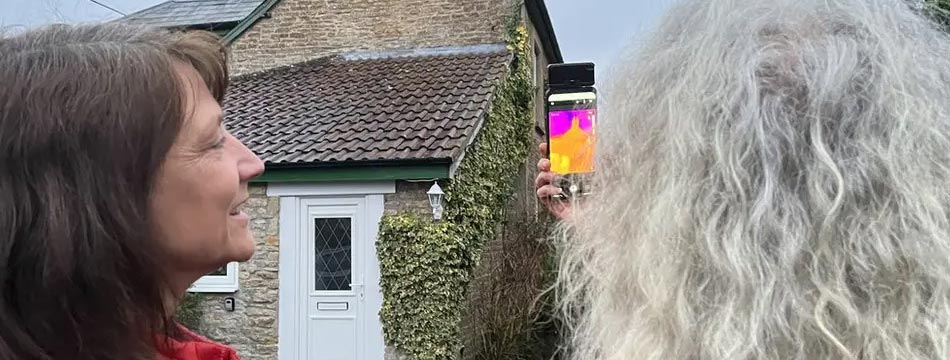
As energy prices rise and we continue to look for new ways to reduce our carbon footprints, people have been turning to thermal technology to help them insulate their homes and reduce energy costs. In January and February 2022, The Times, the BBC, and PASS all published stories about people, councils, and charities using thermal cameras to assess and address insulation issues within their homes.
Quick Links
- Cambridge Carbon Footprint Uses FLIR C5 to Reduce Emissions
- South Somerset Stops Heat Loss Using Thermal Cameras
- The Times Tells of How Thermal Technology Helped Homeowners Across the UK
- Further Information
Cambridge Carbon Footprint Uses FLIR C5 to Reduce Emissions
Cambridge Carbon Footprint, a charity committed to raising awareness of climate change and helping people achieve low-carbon living, has implemented a thermal camera training and loan scheme. The program is designed to assist people with identifying and addressing energy efficiency issues in their homes and workplaces. By providing property owners with thermography training and a loaned Fluke TiR, Fluke TiR105, or FLIR C5 Thermal Camera, the charity hopes that by making heat loss visible more homeowners will be motivated to implement the improvements needed to prevent energy waste. Cambridge Carbon Footprint points out that by addressing issues such as draught, damp, and faulty insulation, individuals can reduce their carbon emissions and energy bills while benefitting from significant improvements in comfort.[1]
For the full story, please click here.
South Somerset Stops Heat Loss Using Thermal Cameras
On the 17th January 2022 Ruth Bradley, a Political Reporter for BBC Somerset, published an article detailing two projects implemented by the South Somerset District Council to help residents save on their energy bills. One of these schemes, set up by South Somerset Lib Dem district councillor Henry Hobhouse, involves using thermal imaging cameras to show the inhabitants of Castle Cary and Bruton where heat is escaping from their homes. Mr Hobhouse explains how a few years ago "he drove past 400 homes in Yeovil with a similar camera… and was amazed at how much heat was being lost out of poorly-insulated front doors."
The project partners with Retrofit Bruton and Cary, set up by the local town council and funded by Somerset Climate Emergency Community Fund, which looks after the council’s two thermal cameras. Justine Mallinson, who currently works for the organisation and has 15 years of experience within the retrofit industry, says
“People are very engaged in doing something to their property, and as our gas and electric bills go up, there’s never been a better time to insulate your property than now.”
Some of the improvements noted in the article are simple and inexpensive, for example, shutting your curtains at dusk and, if possible, tucking them behind a radiator. However, the article also points readers towards South Somerset Council’s advice on accessing grants and funding for energy improvements.[2]
The complete article is available on the BBC News website.
The Times Tells of How Thermal Technology Helped Homeowners Across the UK
Jayne Dowle’s article published on The Times' website on the 4th February 2022 reveals how multiple homeowners across England have improved the energy efficiency of their houses to reduce climbing heating bills. In the article, Dowle explains how Rupert Gregory saved 20% on his dual fuel bill after investing in draught-proofing and insulation measures. To find and visualise sources of heat loss in his home, Gregory borrowed a FLIR thermal camera from the energy supplier Octopus Energy. Blue spots on thermal images enabled Gregory to find draughts along his floors, skirting boards, and under doors, as well as dislodged insulation in one bedroom.
Mick Wall from Sheffield also borrowed a thermal imaging camera from Octopus Energy. Last year he used this camera to discover why his front bedroom did not retain heat. Colder spots on the thermal image revealed that there was no insulation between the internal plasterboard and outside tiles underneath his bay window. Uncovering this problem meant Mick Wall could address it effectively by employing a local builder to insulate the problem area.
In Sharston, South Manchester, the Greater Manchester Carbon Co-op lent a thermal camera to Chris Williams who discovered that he was not losing heat through his walls as he suspected but through his windows. A thermal image, taken from the outside of his house, depicted the walls in blue, a good sign suggesting that they were containing the heat inside the house, while the windows showed up as red, indicating that heat was escaping out of the house through these areas. Thermal imaging enabled Williams to identify problem areas clearly; now he can invest his money into targeted insulation solutions, in this instance, upgrading his windows.[3]
For the complete article, please visit The Times’ website.
Further Information
For more help and advice about using thermal imaging to reduce your energy bills and carbon footprint, as well as further information regarding our building diagnostics thermal cameras, including models by Teledyne FLIR and Hikmicro, please contact our Sales team on 01642 931 329 or via our online form.
[1] Jessica Wright, 'Charity Uses Thermal Cameras to Reduce Property Owners’ Carbon Footprints', PASS Ltd, last accessed 23 February 2022
[2] Ruth Bradley, ‘Energy bills: Thermal imaging used to help with cost of heat loss’, BBC News, last accessed 23 February 2022
[3] Jayne Dowle, ‘How to cut your energy bills at home using geothermal imaging cameras’, The Times, last accessed 23 February 2022


